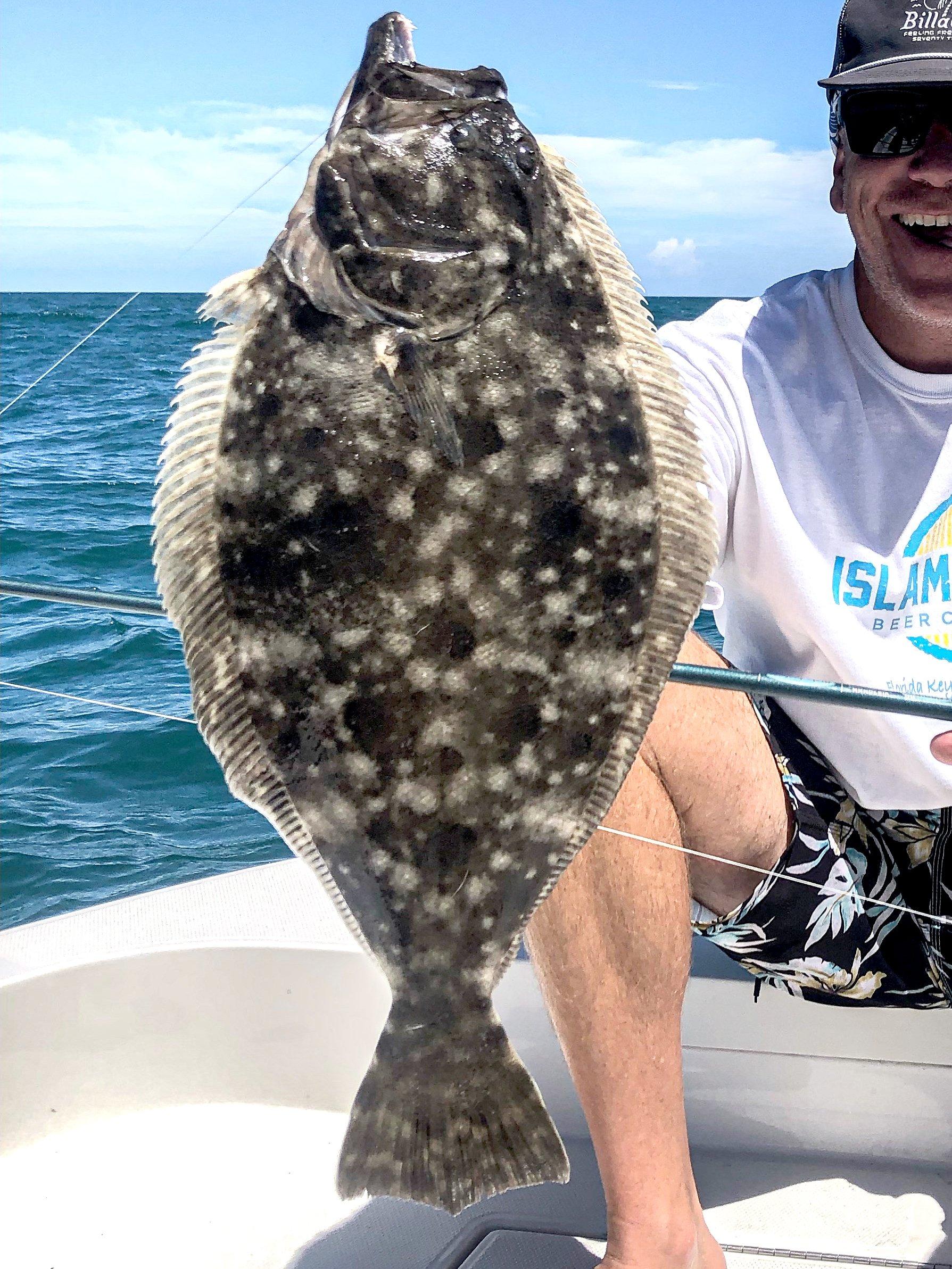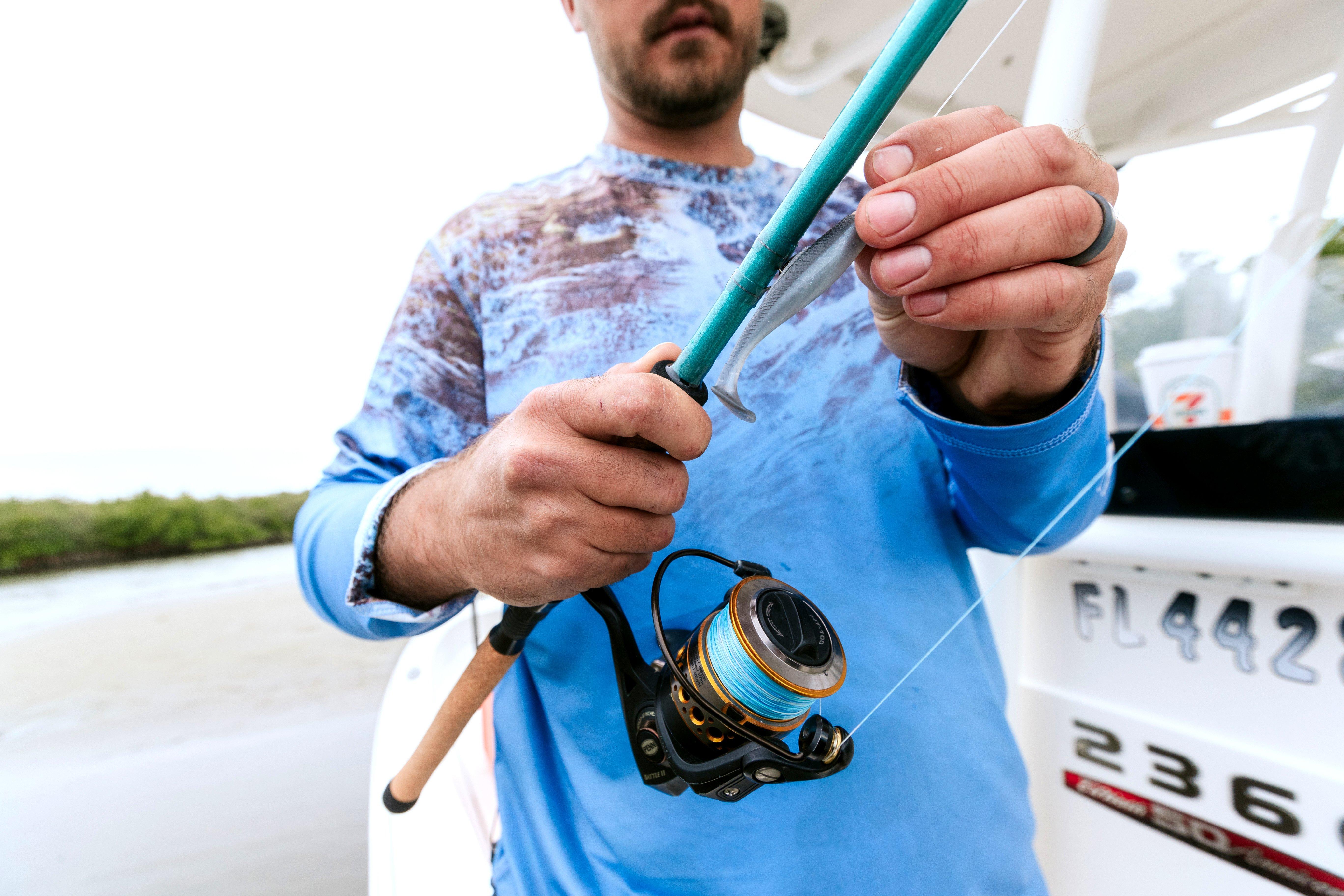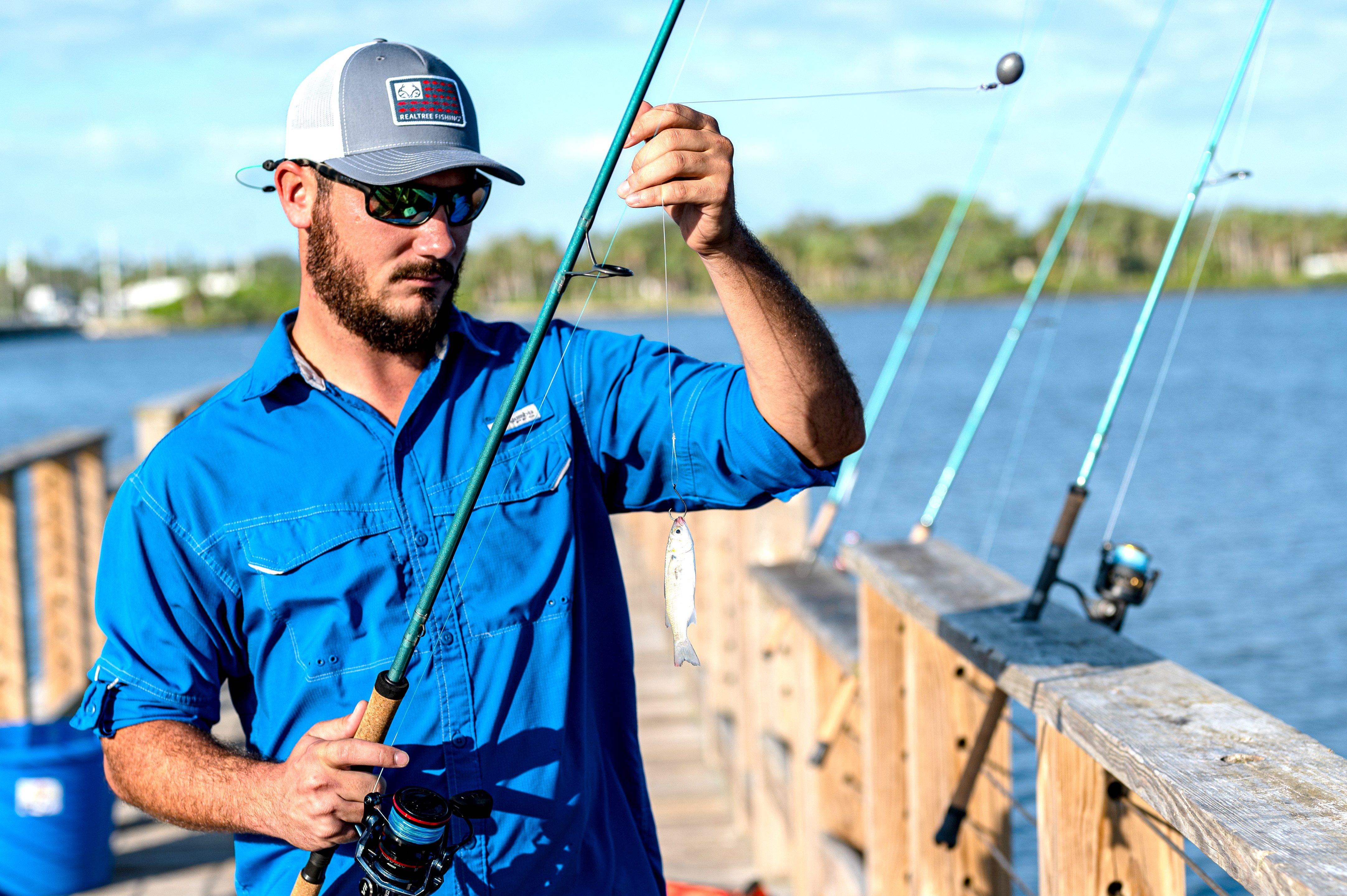Flounder are easy to catch once you understand their habits, and they’re delicious on the table. Early fall is prime time, too

Big flounder won't win beauty contests, but they are delicious to eat and easy to catch with the right tactics. Image by Millennium Promotions, Inc.
Flounder, being one of the ugliest fish in the sea, are always an underdog. Ask any saltwater angler to name their favorite fish, and you’ll hear votes for redfish and mahi mahi. Grouper, trout, and cobia have perpetual fans. You won’t hear mention of flounder.
In the Northeast, flounder are referred to as fluke. There’s a bit of a following there — the New Jersey crew and neighbors on each side make a solid effort in pursuit of the flatfish. But you won’t read much about flounder fishing in the big magazines or websites, where pages are filled with offshore adventures to far-away locales.
Maybe that’s because you don’t need a 50-class reel or a boat with four outboards to catch a flounder. Don’t worry about push poles or kites or cast nets or chum. Just get a couple spinning rods and follow along. Here, we’ll uncover the secrets to the everyman’s saltwater fish, the one of the ugliest fish in the sea that’s also one of the tastiest.

Paddle-tail swimbaits are an excellent choice for flounder. Image by Millennium Promotions, Inc.
WHAT IS A FLOUNDER?
Flounder are members of a group of flatfishes that include species from around the world, including halibut. These fish feature a strange characteristic of having “migrating eyes.” Juveniles develop eyes on each side of their head but later, as the fish mature, one eye migrates to join the other. Adult flatfish have a top and bottom, rather than a left and right, and so both eyes are on top, which allows a flounder to ambush prey while lying on the sea floor.
Flounder are masters of camouflage and predatory ambush. Many anglers mistakenly think flounder are poor at capturing prey but they’re actually excellent hunters capable of impressive bursts of speed and engulfing unsuspecting food fish. A flounder strike is anything but subtle. Their mouths are large and contain sharp teeth.
The key to finding productive hotspots for flounder revolves around their ambush feeding behavior, as well as body form. Being flat, flounder can inhabit areas with extremely strong current. They simply root in on the bottom, and let the water flow over them. Objects that block current, which flounder can sit behind and hunt, also help.
Many flounder species spend a portion of their time in inshore estuaries. Some migrate in and out of inlets to the ocean. Others never come inshore as adults. Each area of the country has different flounder fisheries, but tactics to catch flatfish remain simple and relatively similar.
Don’t Miss: HOW MICKA BURKHART BROKE THE STATE BLUE CATFISH RECORD TWICE

Fish-finder rigs are productive in heavy current. Image by Millennium Promotions, Inc.
WHERE TO FIND FLOUNDER
Here in Florida, most flounder fishing is done inshore, with a little occurring on nearshore grounds of the Atlantic and Gulf. More about that in a minute.
The key to inshore flounder fishing success is intimately learning your home waters. Flounder are almost certainly close by, but inshore habitat often varies. In areas with large, sandy flats and little vegetation, flounder often concentrate on shallow ditches and drop-offs. Creek and river mouths are textbook. Anywhere that a shallow area drains, and has a slight drop-off, can be a flounder hotspot. The key is to look for flowing water coming over sandbars as the tide runs, and key on the closest drop. I’m always amazed at how shallow flounder can be in this scenario. Remember, even a big flounder is only a few inches thick; few predator fish can get shallower.
You’ll see mud minnows and small mullet around sandbars and creek mouths, both of which are favorites on the flounder’s menu. I’ve often felt the flounder actually have a special affinity for the smell of mullet; numerous times I’ve caught them on a dead piece of mullet when nothing else triggered a strike.
A simple jighead and bait works here, whether the offering be real or fake. Plastic paddletails are very effective, as are shrimp imitators.
Die-hard flounder anglers love spinnerbaits. Saltwater versions are much like freshwater bass lures in design; the safety-pin type, with a blade spinning on an arm above a leadhead. In the salt, however, plastic baits are subbed for silicone skirts, and lure frames tend to be heavy-duty.
Regardless of the bait choice, keep moving, but bump bottom continuously. Remember, flounder are always on the bottom.
In other inshore locales, oyster bars are the primary places to find flounder. Here, waters can be shallow or deep. The principle is the same as sandbar fishing. Oyster bars break the current, attract food (still mullet, but also crabs and pinfish), and feature a down-current drop-off that holds flatties.
You’ll need a jig heavy enough to tick bottom, but not hang up. That often takes rigging two baits for various stages of the tide. Remember, even strong current can still produce flounder. Jig and plastics work, as do spinnerbaits, but subbing in a live bait on a fish-finder rig can be tops, especially in strong current.
Start with a sliding sinker heavy enough to hold bottom, followed by a swivel. Attach a short, abrasion-resistant leader (12 inches of 40-lb fluorocarbon works well), followed by a live bait hook. I love a Kahle-style hook, as it possesses both circle and J-hook characteristics, and seems to really hook flounder well.
Any current break can hold inshore flounder. Boat docks are famous flounder haunts. Cast and retrieve baits past pilings, just like bass fishing. Anything that bumps bottom can work. Try multiple pilings quickly, rather than soaking baits.
Check out your inshore fishery and ask yourself: what breaks the flow of water on the bottom? Big mangrove trees certainly do, as do jetties and seawalls. Look for a point in these manmade structures.
Permanent channel markers hold flounder. Even the anchors holding down buoys attract fish, often the biggest. The key is to get your bait down behind the object where the water is flowing.
For inshore flounder, a 7-foot, medium / heavy spinning rod is all you need. Spool with 30-pound braid and carry leader material. A few lures, sinkers, and hooks round out your tackle needs.
WADE-FISHING FLOUNDER
Wading can be extremely productive for flounder in certain scenarios. Again, being a very shallow-water fish, flounder can sometimes be difficult to reach by boat without spooking. Then, it’s often best to beach the rig and jump out.
Backwater holes and creek mouths hold flounder that many anglers never see. Shorelines with undercut banks — especially those with large mangroves — can be dynamite. A single flooded bush produced my two largest inshore flounder this year.
It goes without saying that caution must be used when wading intracoastal and estuary areas due to sharp oysters. Add a pair of old tennis-shoes to your tackle bag. Spinnerbaits rule for this type of angling, as they cover massive amounts of water efficiently. The one rod / one lure approach is both fun and widely rewarding. Be sure to carry a stringer.
Don’t Miss: KEY BAITS AND MUST-KNOW TACTICS FOR LEDGE FISHING BASS

Flounder can be caught in exceptionally shallow water, but keep your presentation on the bottom. Image by Millennium Promotions, Inc.
OFFSHORE FLOUNDER
I routinely catch flounder 15 or more miles offshore on artificial reefs. Many of these are real brutes, making for outstanding table fare. The key to offshore flounder is to follow the same plan as inshore, but refine your tackle for the approach.
On wrecks and reefs, flounder hold on the down-current side of current-blocking objects, just like inshore. However, presenting a bait in water 60 feet deep (or more) can be challenging.
Here, live bait rigs get the nod for their effectiveness in deep water. Mullet are a favorite, but pinfish, mojarra, pilchards, and a host of other baits will work. Start with the lightest sinker that will hold bottom. Anchor directly above rocks and wrecks, and pitch to the down-current side, behind the boat. A rig with sufficient weight can be lifted and dropped, but will settle back to about the same spot.
I’ve refined a knocker rig using a sliding weight above a hook, tied with a large loop-knot and bead. This gives a little distance between my weight and bait, but the rig still performs like a jig.
And jigs work well, too. A 1- to 3-ounce bucktail, depending on depth and current, can be a flounder killer. Most jig aficionados add a curly tail grub for action and color. In the Northeast, anglers tie two baits on the same line: a heavy jig on the bottom, and a high-action plastic as a dropper rig above. Many swear the dropper does all the catching. My attempts to duplicate in Florida have been inconclusive, so I stick to one lure at a time.
Deep-water flounder may require a bit heavier rod, so moving up from a medium-heavy to a heavy power is my choice for big jigs. Again, braided line to a leader, a few baits, and keep moving. I like to bounce around with my trolling motor, strolling down the sides of reefs and rock piles, fishing fairly vertically to prevent snags, but constantly bumping along. Jigging a bait a foot or so off the bottom helps to attract the fish.
Of note: flounder are glutenous predators, and will often take several baits if your first strike is missed. Get back in the same spot, in a hurry.
DRIFTING FOR FLOUNDER
Some locations require anglers to drift large expanses to find flounder. Fish-holding features are subtle, including tapering drop-offs, bottom changes, clam beds, and current breaks. Underwater camera work by expert anglers confirms that flounder often follow lures bouncing on the bottom for long distances, and are triggered by bright colors, hops, and drops. Heavy bucktails, or jigs with flamboyant plastics, take the most fish.
Here, it’s important to control your speed. When drifts exceed a mile an hour, it’s best to use a trolling motor to backtrack a bit, or deploy a drift sock. Once a flounder is caught, be sure to duplicate the drift exactly. If you can anchor or hold the boat in the productive area, all the better.
Another eye-opening detail: it’s extremely common to catch multiple flounder from the exact same spot. Behind the same piling on a dock, or a certain rock on a reef. Many times, while flounder fishing with multiple anglers on my boat, one angler will catch several fish while the others, just a few feet away with identical baits, strike out. Then, we sub in anglers on the “hot-seat” and may catch a half-dozen fish from the honey-hole.
Flounder fishing is my go-to when nobody’s looking. Few fish, for my money, are as tasty. Even better, I often catch dinner without burning much gas, and hardly go through any gear. A bucket of bait, a few lures, and a handful of sinkers and hooks. Doesn’t get much simpler. Mornings on the flounder grounds, a cup of coffee, and a half-day to get away from it all.
The best time of year is now, as fall presents a migration of sorts while the flounder prepare to spawn. Check your regs for closed seasons (Florida closure begins October 15 on both sides), and only keep what you can eat in a meal or two. That will get you back out there more often. It’s a trick I use all the time.
Don’t Miss: THE 5 BEST LIVE-BAIT RIGS MADE FOR WALLEYE FISHING










